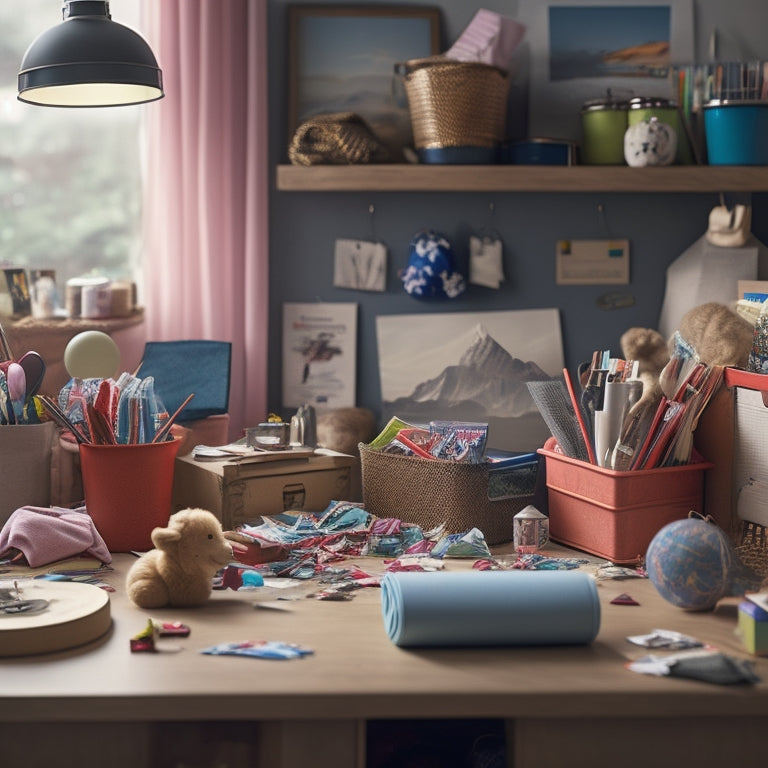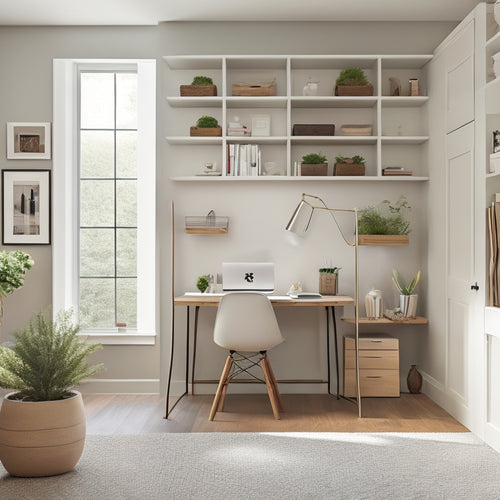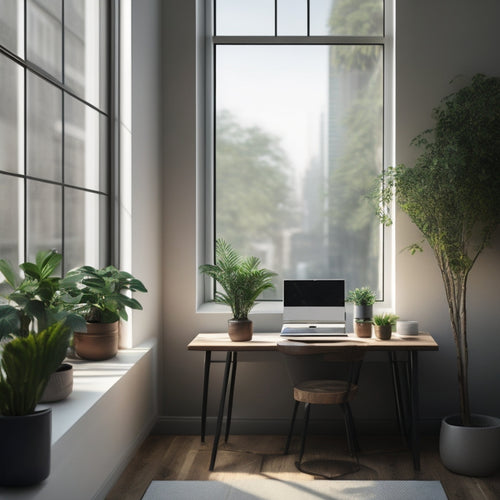
7 Essential Decluttering Strategies for ADHD Brains
Share
You're about to discover the 7 essential decluttering strategies tailored to your ADHD brain. Start with a brain dump to clear mental clutter and gain control. Then, assign designated spots for each item to reduce stress and save time. Next, break down clutter hotspots into manageable chunks and use visual reminders and cues to aid navigation. Implement the one-touch rule to prevent clutter buildup, and schedule regular decluttering sessions to maintain progress. Make it a habit with accountability and discover more actionable tips to help you achieve a clutter-free space that works for you.
Key Takeaways
• Brain dump and mind mapping help clear mental clutter, process thoughts, and establish structure for ADHD brains.
• Assigning designated spots for items reduces stress, saves time, and maintains order and structure.
• Implementing the one-touch rule prevents clutter buildup and decision fatigue by deciding the fate of each item instantly.
• Scheduling regular decluttering sessions helps stay on top of messes and make steady progress, creating a habit of regular decluttering.
• Creating a decluttering schedule and establishing an accountability partnership provide structure and support for maintaining organization and achieving goals.
Start With a Brain Dump
Begin by setting a 10-minute timer and writing down every task, thought, and reminder swirling in your head, no matter how big or small, to create a brain dump that clears mental clutter and gives you a sense of control. This exercise helps you process your thoughts, feelings, and to-do's, allowing you to release emotional baggage and gain clarity.
As you write, don't worry about organization or grammar; just let it all out. This brain dump can be a therapeutic emotional release, freeing you from mental overwhelm.
Next, take a step back and review your brain dump. Look for patterns, themes, and connections between tasks and ideas. This is where Mind Mapping comes in. Create a visual representation of your thoughts, grouping similar items together and using colors, symbols, and images to make it more engaging.
This visual approach helps you see the big picture, identify priorities, and create a sense of structure. By combining brain dumping and Mind Mapping, you'll be able to tackle your tasks and responsibilities with renewed energy and focus.
Create a Home for Each Item
Now that you've purged your space of unnecessary items, it's time to create a home for each item you're keeping.
You'll need to assign a designated spot for everything, making it easy to find what you need when you need it.
Assign a Designated Spot
Assigning a designated spot for each item helps you maintain order and structure, ensuring that you can easily find what you need when you need it. This strategy is essential for ADHD brains, as it reduces stress and saves time. By designating a specific spot for each item, you create a sense of routine and habit, making it easier to put things back in their place. This, in turn, helps you develop a sense of responsibility and ownership over your belongings.
To make the most of this strategy, identify spot anchors – specific locations that serve as a reference point for where items belong. These anchors can be visual landmarks, such as a hook for your keys or a tray for your wallet. By creating a mental map of your space, you can quickly recall where each item is stored. This visual system helps you stay organized and focused, even when your ADHD brain is tempted to get distracted.
Label and Sign It
You take decluttering to the next level by labeling and signing each designated spot, creating a visual system that reinforces your new habits and helps you quickly identify where each item belongs. This step is essential for ADHD brains, as it provides a clear and consistent reminder of where things go.
Use color coding to categorize items, such as labeling all cleaning supplies with a blue marker or all office supplies with a red one. This visual cue helps your brain quickly associate the item with its designated spot.
Personalization is also key. Use your name or initials on the label to make it clear that the spot belongs to you. This sense of ownership can help you feel more invested in maintaining the organization system.
Consider using pictures or icons on the labels for items that are difficult to read or understand. By labeling and signing each spot, you're creating a system that works with your ADHD brain, not against it. This visual system will help you stay on track and maintain your newly organized space.
Store It Out
By designating a specific home for each item, you create a sense of containment that helps your ADHD brain relax, knowing exactly where to find what you need. This strategy is all about assigning a designated spot for each item, making it easier to locate and put away.
Start by categorizing items into groups, such as office supplies, kitchen utensils, or craft materials. Then, allocate a specific container or shelf for each group. Use hidden containers or bins to store items that you don't need immediate access to, like seasonal decorations or out-of-season clothing. This will help reduce clutter and visual overwhelm.
To avoid clutter buildup, implement overflow strategies. For instance, set a limit on the number of items you can store in a particular container. Once that limit is reached, it's time to purge or donate excess items. You can also schedule regular tidying sessions to maintain your newly organized space.
Break Down Clutter Hotspots
Your clutter hotspots, those areas where clutter tends to accumulate and overwhelm, need to be broken down into manageable chunks to tackle effectively. To do this, you'll want to identify your clutter patterns - the reasons why clutter accumulates in certain areas.
Is it because you tend to drop your belongings near the door? Do you have a habit of leaving dirty dishes in the sink? Once you understand your patterns, you can start hotspot mapping. This involves creating a mental or physical map of your clutter hotspots, noting the areas that need the most attention.
Use Visual Reminders and Cues
Visual reminders and cues become essential tools in the decluttering process, as they help ADHD brains stay on track and maintain focus amidst the chaos. You can use visual reminders to create a sense of organization and structure, making it easier to navigate your space.
Try using color coding to categorize items, such as labeling files or folders with different colors to distinguish between categories. This visual system helps you quickly identify what you need and where it's located.
Mind maps are another effective visual tool to aid in decluttering. By creating a visual representation of your tasks and goals, you can break down complex tasks into manageable chunks. This helps you stay focused and motivated, as you can see the progress you're making.
You can also use mind maps to plan out your decluttering process, identifying areas that need attention and prioritizing tasks. By incorporating visual reminders and cues into your decluttering routine, you'll be better equipped to stay on track and achieve your goals.
Implement the One-Touch Rule
When implementing the One-Touch Rule, you'll want to handle each item immediately, making a decision fast about what to do with it. This means you won't put it down and deal with it later - you'll take action right away.
Handle It Immediately
Implementing the one-touch rule involves dealing with each item as soon as you touch it, making a decision about its fate in that moment. This approach eliminates the need for revisiting the same item multiple times, saving you time and energy.
When you handle an item, take immediate action - either put it away, throw it away, or delegate it. Don't put it down and deal with it later; that's a recipe for procrastination.
This strategy is particularly effective for ADHD brains, which often struggle with time sensitivity. By taking instant action, you're leveraging your natural tendency towards impulsivity to your advantage. You're also reducing decision fatigue, as you're not leaving the item to linger and weigh on your mind.
Handling each item immediately also helps you stay focused on the task at hand. You're not getting bogged down by indecision or allowing clutter to accumulate. By taking control of each item as soon as you touch it, you're maintaining momentum and making steady progress towards a clutter-free space.
Make a Decision Fast
You're already making great progress by handling items immediately, and now it's time to take it a step further by making a decision about each item the moment you pick it up. This is where the One-Touch Rule comes in – a game-changer for ADHD brains.
When you touch an item, make a rapid choice about what to do with it: keep, donate, recycle, or discard. Don't put it down; take swift action instead.
The key is to avoid procrastination and indecision. Your brain can get overwhelmed by too many options, so simplify the process. Ask yourself: 'Do I need this? Can I replace it if I need it again?' Be honest with yourself, and make a decision quickly. Don't worry if it's not perfect; you can always adjust later.
Put It Away Now
Implementing the One-Touch Rule is essential for ADHD brains, as it prevents the buildup of clutter and reduces decision fatigue. By putting things away instantly, you'll experience immediate relief from the mental and visual overwhelm that comes with clutter.
When you implement the One-Touch Rule, you'll take instant action on each item, deciding its fate and putting it away in its designated spot. This approach eliminates the need for multiple handling, saving you time and energy in the long run.
You'll no longer spend hours searching for misplaced items or stressing about where things go.
Schedule Regular Decluttering Sessions
Set aside a specific time slot each week to tackle clutter, allowing you to stay on top of messes and make steady progress towards a more organized space. This strategy is called Time Blocking, where you dedicate a fixed time frame to a particular task. By doing so, you'll create a habit of regular decluttering, making it easier to maintain your space.
To make the most of your decluttering sessions, consider Habit Stacking. This involves linking a new habit (decluttering) to an existing habit (e.g., your daily morning routine). This way, you'll create a strong association between the two habits, making it harder to forget or skip your decluttering sessions.
Here's a sample schedule to get you started:
| Day | Time | Task |
|---|---|---|
| Monday | 30 minutes | Quick pick-up of toys and books |
| Wednesday | 30 minutes | Organize kitchen utensils and countertops |
| Friday | 1 hour | Tackle a cluttered area of your choice |
| Sunday | 30 minutes | Review and maintain your space |
Make It a Habit With Accountability
By enlisting the help of a friend or family member to hold you accountable, you can guarantee that your decluttering sessions become a consistent habit. This Accountability Partner will provide an added motivation to stay on track and make certain that you're not putting off tasks until the last minute.
To make the most of this partnership, schedule Daily Check-ins with your partner to discuss your progress, goals, and any challenges you're facing. This can be as simple as a quick phone call or text message exchange. Having someone to report to will help you stay committed to your decluttering goals and provide an added sense of responsibility.
Additionally, your partner can offer valuable advice, encouragement, and support when you need it most. By combining regular decluttering sessions with accountability, you'll be more likely to make lasting changes and develop a habit that will benefit your daily life.
Frequently Asked Questions
How Do I Stay Motivated When Decluttering Feels Overwhelming?
When decluttering feels overwhelming, you'll stay motivated by celebrating Breakthrough Moments, no matter how small, and creating a Reward System that treats you to something enjoyable after reaching decluttering milestones, helping you push through the tough times.
What if I Have Sentimental Items I Don't Want to Get Rid Of?
"Can you really let go of memories, or just the physical clutter? Create Memory Boxes for sentimental items, acknowledging your Emotional Attachment, and set a 'review' date to reassess what's truly important to you."
Can I Declutter With a Mental Health Condition Like Anxiety?
When dealing with anxiety, you can declutter by incorporating self-care routines, like meditation and deep breathing, into your process. Take a mindful approach, focusing on one area at a time, to reduce feelings of overwhelm.
How Do I Involve My Family Members in the Decluttering Process?
You're like a conductor leading an orchestra, harmonizing individual efforts into a cohesive whole. Hold Family Meetings to set goals and assign tasks, making decluttering a Team Effort, where everyone contributes and feels invested in the process.
Are There Any Decluttering Strategies Specifically for Digital Clutter?
You'll benefit from setting Digital Boundaries, like scheduling device-free hours, to reduce digital clutter. Implementing Cloud Organization tools, such as categorizing files and using search functions, will also help you efficiently manage your digital space.
Related Posts
-

Optimize Your Small Home Office With Smart Storage
You can instantly boost your productivity and reduce stress by optimizing your small home office with smart storage s...
-

Transform Your Space: 5 Online Courses to Help
Ready to transform your space from cluttered to calm? Start with mastering home organization fundamentals, like declu...

